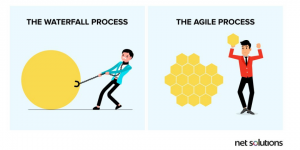When it comes to your business website, adopting a smart, shall we say “savvy” mindset is critical to make it work well for you? Especially in our strange world where the new normal is living behind a screen instead interacting with a real human.
It’s never been more essential and more competitive for businesses to be online. But simply having a website was never just enough before, and it certainly isn’t enough now.
How does a business stay relevant and successful, while protecting the lifespan and ROI of its website? By being Agile, of course.
What is Agile Methodology?
If you’re in business and have somehow not heard of it, here’s the back story. Agile was formally launched in 2001, but to our surprise, it didn’t immediately take over the world. This is because the traditional structure of the Waterfall methodology of project management was, and in a lot of ways still is, entrenched in the tech industry for large projects and/or rebuilds. While old school is certainly cool in many instances, I wouldn’t say that is the case here.

Back in 1999, there were only 3,177,453 websites worldwide. Jump to 2001, and that number increased to 29,254,370. That was a ton of new websites launched using the traditional waterfall model, which proved for many to be too technical documentation orientated, as opposed to actual productivity and momentum focused.
This is where the need for a new, better method came in. A better system for businesses and digital agencies to adapt and make neat stuff happen faster and more efficiently, as a team.
Forward to 2001, when 17 technologists, working together for an undisclosed length of time later – BOOM – the Agile Manifesto was born. And what a beautiful baby it was.
The purpose of Agile is simple and brilliant, and involves 4 major themes:
- Individuals and interactions over processes and tools
- Working software over comprehensive documentation
- Customer collaboration over contract negotiation
- Responding to change over following a plan
But wait…there’s more! Coinciding with the four key themes, the Agile Methodology was also developed around 12 important principles which are even more relevant in today’s online world:
-
-
Early and Continuous Delivery of Valuable Software
- We live in an age of almost instantaneous results. Clients expect updates and results quickly, which is where the iterative process shines. By establishing smaller goals to reach, it is easier and more attainable to deliver results faster, and much, much earlier than a traditional large-scale project.
-
Embrace Change
-

Technology advances at breakneck speed. The flexible framework that an Agile methodology provides allows web teams to pivot swiftly as market & user needs change. Shortly you’ll have a chain, and the longer the chain you create, the more motivation you’ll have to continue doing the tasks A proactive, positive path to prepare for whatever the world throws your way!
-
-
Frequent Delivery
- With continuous, smaller-scaled solutions being delivered, tested, and measured, frequent reporting of success or positive failure is part of the process. Each phase of work can progress more rapidly – with data-driven, proven results – to ensure steady, reliable progress.
-
Business and Developers Together
- At the heart of any successful venture, is communication. Agile embraces the “better together” philosophy, as opposed to keeping team members siloed to their specialty departments. This allows for a multi-disciplined, cross-functional team to collectively add opinions and strategies to better reach a business’ goal.
-
Motivated Individuals
- Choosing the right team is key. Having skilled, driven members – whose skills you trust – is integral to any successful adventure. Empowering, listening, and having your team members’ backs, is just as important as the actual work done. Tell them often, tell them loudly, just how much you appreciate them.

-
Face-to-Face Conversation
- It is a proven fact that the most effective form of communication is real-life conversation. Facial expressions, tone, and body language are still the best signals for understanding and/or interpreting the meaning of a conversation. Thankfully, in today’s world of necessitated segregation, we have tools such as Zoom, Skype, Google Hangouts, Microsoft Teams, and many other worthy media solutions that are at least a close second to a face-to-face conversation.
-
Working Software
- Value is translated to a business when they see working results. With Agile, by iterating & testing consistently, delivery of the best version of all software

will more quickly validate their ROI. With frequent, steady & proven progress, the client can reap the benefits of launched work and see value faster than a traditional long-term project.
-
-
Sustainable Development
- Agile processes allow and promote sustainable development. Proper planning that aligns with company goals means the team can see far ahead, but can easily break down tasks with time-based priorities. Every person and team involved in the project should be able to maintain a constant pace indefinitely.
-
Technical Excellence
- Team members focus on the ability to foresee and eliminate an issue before it has the potential to jeopardize any aspect of the work. By consistently striving to improve technical qualities, while staying open to new approaches, this Agile path will steadily enhance team processes, software craftsmanship, and code quality.
-
Simplicity
- “Simplicity—the art of maximizing the amount of work not done—is essential” [Agile Marketing Manifesto]. This principle is about understanding the goals needed to be reached and the most efficient way to achieve them. With a focus on the desired outcome, as opposed to technical specifications, the team can then brainstorm the best, simplest way to get there. The less custom code the better.
-
Self Organizing Teams
- This principle circles back to picking the right team to work with. By empowering & embracing multi-functional members and conveying trust in all from the beginning…your team will have pride in their work, and be comfortable with contributing to the overall work organization & communication, while also standing on their own two feet when necessary.
-
Regular Reflection and Adjustment
- By embracing a regular routine of looking back and discussing all aspects of the team’s work, you can adjust, pivot, or bounce better strategies off each other to improve the workflow or development processes. No team is perfect. No practices or methods are perfect. Communication is key within the team for positive action and proactive improvement.
-
-
THE KEY IS A FLEXIBLE BOTTOM LINE
Over the last two decades, advancements in technology have been unprecedented. Thankfully, the practices involved in Agile Methodology were meant to stand up alongside mass changes within our industry. This way of being and thinking is 100% effective for gradual, tried-tested-and-true improvements through well-planned, continuous iterations and team contributions. Happy 20th Anniversary to the Agile methodology!
-








